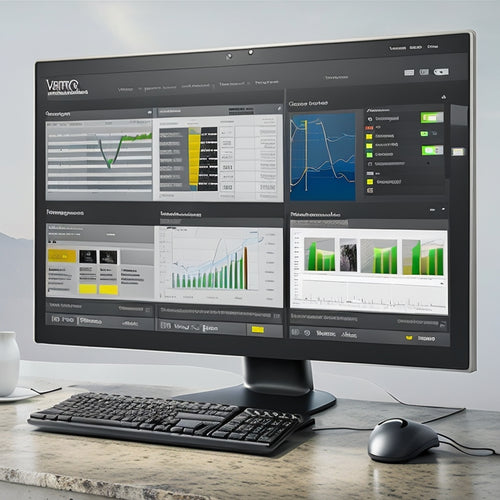
Master Your Moneris: Essential Terminal Processing Tips
Share
To master your Moneris terminal, start by setting it up correctly, configuring hardware according to the manufacturer's instructions, and updating account and contact information. Guarantee stable internet connections and check for software updates regularly to process transactions successfully. Implement chargeback prevention strategies and respond promptly to notifications to minimize financial impact. Review and reconcile reports daily, comparing Terminal Totals with Host Totals to prevent financial losses and ensure regulatory compliance. Finally, maintain up-to-date account information to prevent errors. By following these essential terminal processing tips, you can optimize your Moneris terminal and take your payment processing to the next level.
Key Takeaways
• Configure your terminal hardware and settings according to the manufacturer's instructions to ensure smooth operation.
• Regularly update your software and account information to prevent connectivity issues and ensure compliance.
• Implement chargeback prevention strategies, respond promptly to notifications, and adopt fraud protection measures to minimize financial impact.
• Perform daily transaction reviews, print Terminal Totals Reports, and compare with Host Totals Reports to prevent financial losses and ensure compliance.
• Verify and update your account information, including contact details, bank account information, and business information, to maintain accuracy and security.
Setting Up Your Terminal
Your Moneris terminal setup involves a series of steps that guarantee seamless transaction processing, starting with hardware configuration and account information updates.
To guarantee a smooth setup, begin by configuring your terminal's hardware according to the manufacturer's instructions.
Next, update your account and contact information to make sure accurate transaction processing.
Troubleshooting connectivity issues is vital to prevent transaction failures. Verify that your terminal is properly connected to the internet and that all cables are securely plugged in.
Customizing settings, such as setting up your terminal's time and date, will also ensure accurate transaction processing.
Processing Transactions Successfully
To guarantee seamless and secure transaction processing, configure your terminal to process debit and credit transactions accurately by following a series of critical steps. Confirm a stable internet connection to prevent transaction errors.
Regularly check for software updates to maintain compliance with industry standards. When troubleshooting connection issues, verify that the terminal is properly connected to the internet and that all cables are securely plugged in.
For transaction error handling, identify and rectify issues promptly to minimize revenue loss. Review the Terminal Totals Report daily to detect any discrepancies.
Managing Chargebacks Effectively
In the event of a disputed transaction, a chargeback is initiated by the cardholder's issuing bank, and it is vital to understand the process and take proactive measures to mitigate their impact on your business.
Effective chargeback management involves implementing chargeback prevention strategies, such as verifying cardholder information and ensuring transactions are accurate and legitimate.
Dispute resolution is also critical, and merchants should respond promptly to chargeback notifications to resolve the issue efficiently.
By adopting chargeback best practices, such as fraud protection measures, businesses can minimize the risk of chargebacks and reduce their financial impact.
Reviewing and Reconciling Reports
Accurate financial reporting is crucial for businesses, and reviewing and reconciling reports is a critical step in safeguarding the integrity of transactional data.
To guarantee precision, perform a daily transaction review to identify any discrepancies. Print the Terminal Totals Report to verify the totals processed each day, and compare it with the Host Totals Report online to identify any variances.
If variances are found, troubleshoot the issue by checking for errors in transactions, batching, or settlement. Report reconciliation is fundamental to prevent financial losses and ensure compliance with regulatory requirements.
Maintaining Your Account Information
Regularly updating account and contact information is crucial for maintaining seamless communication and avoiding potential disruptions to your merchant services. This critical task helps uphold the accuracy of your profile and prevents miscommunication that can lead to financial losses.
To make sure your account information is up-to-date, follow these essential steps:
-
Verify contact details: Confirm your business address, phone number, and email are current to receive important notifications and statements.
-
Review account updates: Check for any changes to your account status, payment schedules, or settlement information.
-
Confirm bank account information: Validate your bank account details to prevent payment processing errors.
- Validate business information: Confirm your business name, tax ID, and other crucial information are accurate and up-to-date.
Frequently Asked Questions
How Do I Update My Terminal's Time and Date Settings?
"When synchronizing your terminal's clock, navigate through troubleshooting steps to adjust the time zone, ensuring seamless transactions. Perform software updates or manual adjustments to guarantee accuracy, safeguarding your business from potential discrepancies."
Can I Use My Terminal With a Third-Party Payment Processor?
When considering third-party payment processor integration, guarantee the terminal's security features align with the new processor's requirements, and assess potential security concerns. Additionally, evaluate the terminal's customization capabilities to guarantee seamless payment flexibility.
What Is the Recommended Maintenance Schedule for My Terminal?
For peak performance and security, adopt a diligent maintenance schedule, including regular cleaning instructions, timely battery replacement, and prompt software updates to guarantee fortified security features, safeguarding your terminal and transactions.
How Do I Troubleshoot a Paper Jam in My Terminal's Printer?
To troubleshoot a paper jam in your terminal's printer, make sure the printer is turned off, then carefully remove any jammed paper from the printer's rollers. Check terminal settings to make sure the correct time and date are set to prevent printing errors.
Is My Terminal Compatible With EMV Chip Cards?
Your terminal is likely compatible with EMV chip cards, as modern terminals support EMV chip technology, ensuring secure transactions with enhanced security measures, such as encryption and tokenization, to protect sensitive customer data.
Related Posts
-

Unlock Ecommerce Growth With Digital Downloads
You're on the brink of accessing ecommerce growth with digital downloads! By incorporating them into your strategy, y...
-

The Power of Website Personalization: Boost User Experience and Conversion
Website personalization has become an increasingly prevalent practice, aiming to enhance user experience and boost c...
-

Products Shopify Apps Support Merchants in Managing and Analyzing Their Product Offerings, With Features Like Bulk Product Editors and Inventory Analysis Systems
This article explores the role of products Shopify apps in assisting merchants with the management and analysis of t...


